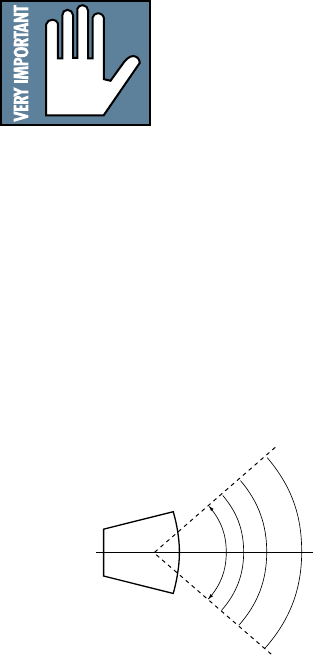
7
PLACEMENT
The FUSSION 3000 active loudspeakers
are designed to sit on the floor or to be sus-
pended by the rigging points.
You can stack cabinets vertically. If you
do, turn the upper cabinet upside down so
the high-frequency driver is closest to the
high-frequency driver in the lower cabinet.
You can create a horizontal array by plac-
ing the cabinets side-by-side. However, you
should have a good understanding of the re-
lationship between the splay angle (the
angle between the facing sides of the cabi-
nets), the on-axis power, and frequency
cancellation effects between cabinets.
When two cabinets are placed side-by-
side, the actual splay angle is 30º
(determined by a 15º angle on each cabinet
side). As the splay angle increases toward
the angle of horizontal coverage (80º for
the FUSSION 3000), the on-axis power de-
creases, but the frequency response
becomes smoother as the comb-filtering ef-
fects (caused by the interaction in the area
of double-coverage) decrease.
As with any powered
components, protect
them from moisture. If
you are setting them up
outdoors, make sure they
are under cover if you expect rain.
Room Acoustics
The FUSSION 3000 loudspeakers are
designed to sound as neutral as possible;
that is, to reproduce the input signal as ac-
curately as possible.
Room acoustics play a crucial role in the
overall performance of a sound system.
However, the wide high-frequency disper-
sion of the FUSSION 3000 helps to
minimize the problems that typically arise.
Here are some other placement tips:
• Avoid placing loudspeakers in the
corners of a room. This increases the
Top
80
0
Dispersion
up to 18kHz
80
0
low-frequency output and can cause the
sound to be muddy and indistinct.
• Avoid placing loudspeakers against a wall.
This, too, increases the low frequency
output, though not as much as corner
placement. However, if you do need to
reinforce the low frequencies, this is a
good way to do it.
• Avoid placing the active monitors directly
on a hollow stage floor. A hollow stage
can resonate at certain frequencies,
causing peaks and dips in the frequency
response of the room. It’s better to place
the active monitors on a sturdy table or
tripod stands.
• Position the active monitors so the high-
frequency drivers are 2 to 4 feet above ear
level for the audience (make allowances
for a standing/dancing in the aisles
audience). High frequencies are highly
directional and tend to be absorbed much
easier than lower frequencies. By provid-
ing direct line-of-sight from the active
monitors to the audience, you increase the
overall brightness and intelligibility of the
sound system.
• Highly reverberant rooms, like many
gymnasiums and auditoriums, are a
nightmare for sound system intelligibility.
Multiple reflections off the hard walls,
ceiling, and floor play havoc with the
sound. Depending on the situation, you
may be able to take some steps to mini-
mize the reflections, such as putting
carpeting on the floors, closing draperies
to cover large glass windows, or hanging
tapestries or other materials on the walls
to absorb some of the sound.
However, in most cases, these remedies
are not possible or practical. So what do
you do? Making the sound system louder
generally doesn’t work because the
reflections become louder, too. The best
approach is to provide as much direct
sound coverage to the audience as pos-
sible. The farther away you are from the
speaker, the more prominent will be the
reflected sound.
Use more speakers strategically placed so
they are closer to the back of the audience.
If the distance between the front and back
speakers is more than about 100 feet, you
should use a delay processor to time-align
the sound. (Since sound travels about 1
foot per millisecond, it takes about 1/10 of
a second to travel 100 feet.)














